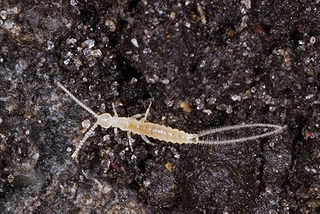
The order Diplura is one of three orders of non-insect hexapods within the class Entognatha. The name "diplura", or "two tails", refers to the characteristic pair of caudal appendages or filaments at the terminal end of the body.

The Pterygota are a subclass of insects that includes all winged insects and the orders that are secondarily wingless.
Several wingless hexapods are known as bristletails:
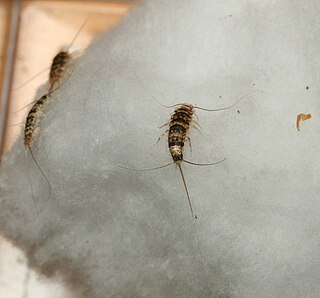
The firebrat is a small insect, in the order Zygentoma.

The name Apterygota is sometimes applied to a former subclass of small, agile insects, distinguished from other insects by their lack of wings in the present and in their evolutionary history; notable examples are the silverfish, the firebrat, and the jumping bristletails. Their first known occurrence in the fossil record is during the Devonian period, 417–354 million years ago. The group Apterygota is not a clade; it is paraphyletic, and not recognized in modern classification schemes. As defined, the group contains two separate clades of wingless insects: Archaeognatha comprises jumping bristletails, while Zygentoma comprises silverfish and firebrats. The Zygentoma are in the clade Dicondylia with winged insects, a clade that includes all other insects, while Archaeognatha is sister to this lineage.

The Archaeognatha are an order of apterygotes, known by various common names such as jumping bristletails. Among extant insect taxa they are some of the most evolutionarily primitive; they appeared in the Middle Devonian period at about the same time as the arachnids. Specimens that closely resemble extant species have been found as both body and trace fossils in strata from the remainder of the Paleozoic Era and more recent periods. For historical reasons an alternative name for the order is Microcoryphia.

The Auchenorrhyncha suborder of the Hemiptera contains most of the familiar members of what was called the "Homoptera" – groups such as cicadas, leafhoppers, treehoppers, planthoppers, and spittlebugs. The aphids and scale insects are the other well-known "Homoptera", and they are in the suborder Sternorrhyncha.

The Entognatha are a class of wingless and ametabolous arthropods, which, together with the insects, makes up the subphylum Hexapoda. Their mouthparts are entognathous, meaning that they are retracted within the head, unlike the insects. Entognatha are apterous, meaning that they lack wings. The class contains three orders: Collembola, Diplura and Protura. These three groups were historically united with the now-obsolete order Thysanura to form the class Apterygota, but it has since been recognized that the hexapodous condition of these animals has evolved independently from that of insects, and independently within each order. The orders might not be closely related, and Entognatha is now considered to be a paraphyletic group.

The Machilidae are a family of insects belonging to the order Archaeognatha. There are around 250 described species worldwide. These insects are wingless, elongated and more or less cylindrical with a distinctive humped thorax and covered with tiny, close-fitting scales. The colour is usually grey or brown, sometimes intricately patterned. There are three "tails" at the rear of the abdomen: two cerci and a long central epiproct. They have large compound eyes, often meeting at a central point. They resemble the silverfish and the firebrat, which are from a different order, Zygentoma.
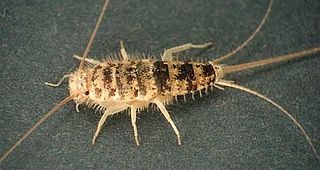
Zygentoma are an order in the class Insecta, and consist of about 550 known species. The Zygentoma include the so-called silverfish or fishmoths, and the firebrats. A conspicuous feature of the order are the three long caudal filaments. The two lateral filaments are cerci, and the medial one is an epiproct or appendix dorsalis. In this they resemble the Archaeognatha, although the cerci of Zygentoma, unlike in the latter order, are nearly as long as the epiproct.

In arthropods, the maxillae are paired structures present on the head as mouthparts in members of the clade Mandibulata, used for tasting and manipulating food. Embryologically, the maxillae are derived from the 4th and 5th segment of the head and the maxillary palps; segmented appendages extending from the base of the maxilla represent the former leg of those respective segments. In most cases, two pairs of maxillae are present and in different arthropod groups the two pairs of maxillae have been variously modified. In crustaceans, the first pair are called maxillulae.
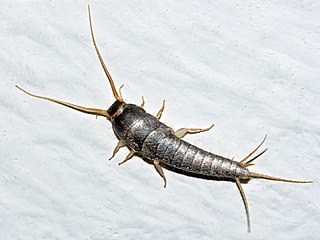
The silverfish is a species of small, primitive, wingless insect in the order Zygentoma. Its common name derives from the insect's silvery light grey colour, combined with the fish-like appearance of its movements. The scientific name indicates that the silverfish's diet consists of carbohydrates such as sugar or starches. While the common name silverfish is used throughout the global literature to refer to various species of Zygentoma, the Entomological Society of America restricts use of the term solely for Lepisma saccharinum.

Psocodea is a taxonomic group of insects comprising the bark lice, book lice and parasitic lice. It was formerly considered a superorder, but is now generally considered by entomologists as an order. Despite the greatly differing appearance of parasitic lice (Phthiraptera), they are believed to have evolved from within the former order Psocoptera, which contained the bark lice and book lice, now found to be paraphyletic. They are often regarded as the most primitive of the hemipteroids. Psocodea contains around 11,000 species, divided among four suborders and more than 70 families. They range in size from 1–10 millimetres (0.04–0.4 in) in length.

Paraneoptera or Acercaria is a superorder of insects which includes lice, thrips, and hemipterans, the true bugs. It also includes the extinct order Permopsocida, known from fossils dating from the Early Permian to the mid-Cretaceous.
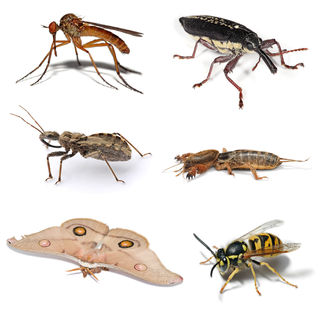
The Dicondylia are a taxonomic group (taxon) that includes all insects except the jumping bristletails (Archaeognatha). Dicondylia have a mandible attached with two hinges to the head capsule (dicondyl), in contrast to a hypothetical ancestral mandible with a single ball joint (monocondyl); the members of Archaeognatha do in fact have dicondylic mandibles, though they are not identical to the structure seen in "true" dicondylic insects.
Ametabolism is a type of growth or life cycle in insects in which there is slight or no metamorphosis, only a gradual increase in size. It is present only in primitive wingless insects: the orders Archaeognatha and Zygentoma.

Tricholepidion is a genus of wingless insect belonging to Zygentoma, with only a single described species T. gertschi, native to the northern coast of California in Western North America. It lives under dead bark and in rotting wood of conifers in mesophytic forests. It is alternatively considered the only living member of the family Lepidotrichidae, which also includes Lepidotrix from Eocene aged European amber, or the only member of the family Tricholepidiidae. The taxonomic position of Tricholepidion is uncertain, in some molecular phylogenetics studies it has been recovered as less closely related to flying insects (Pterygota) than the rest of Zygentoma is, rendering Zygentoma paraphyletic. Each compound eye contains ~40 ommatidia, and they have three ocelli. Scales on the body are absent. Unlike Archaeognatha and the other families of Zygentoma, which have three- and sometimes two-segmented tarsi, they have five-segmented tarsi like many winged insects.
Machilinus aurantiacus is a species of rock bristletail in the family Meinertellidae. It is found in North America. Adults are 6-8 mm in length and covered in silvery scales. Legs are yellow-brown. This species is diurnally active.

Petridiobius arcticus is a species of jumping bristletail in the family Machilidae. It is found in Europe and Northern Asia and North America.
















